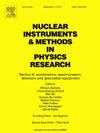Beam dynamics design of a proton/heavy-ion injector for the synchrotron of the XiPAF upgrading project
IF 1.5
3区 物理与天体物理
Q3 INSTRUMENTS & INSTRUMENTATION
Nuclear Instruments & Methods in Physics Research Section A-accelerators Spectrometers Detectors and Associated Equipment
Pub Date : 2025-04-14
DOI:10.1016/j.nima.2025.170537
引用次数: 0
Abstract
In the multi-turn injection process of proton and heavy-ion synchrotrons, reducing the transverse emittance of the injected beam enhances injection gain, thereby increasing the number of particles stored in the synchrotron. An injector with low emittance growth is advantageous for achieving a low-transverse-emittance beam at the injection point. This paper presents the results of the beam dynamics design for a low-transverse-emittance injector intended for a proton/heavy-ion synchrotron of the Xi'an 200 MeV Proton Application Facility (XiPAF) upgrading project. The injector comprises two dedicated injection lines that accelerate and transport the protons and heavy-ions, along with a shared line to direct the beams into the synchrotron. While the proton injection line is developed from upgrading of the existing H− beam line, the heavy-ion injection line is newly constructed. A heavy-ion IH-DTL featuring negative phase acceleration and FODO focusing has been adopted. Its acceleration phase and acceleration voltage have been optimized to suppress the emittance growth. The beam dynamics of the linac-to-ring beam transport line (LRBT) has been optimized, employing three sets of beam scrapers to further reduce emittance. Simulations using the TraceWin code demonstrate that the normalized transverse emittances (99 % particles) at the injection point are ensured to be less than 1.2 π mm·mrad for the proton beam and 1.05 π mm·mrad for the heavy ion beams. A comprehensive error analysis, accounting for errors from the input beams, solenoids, quadrupoles, debunchers, RF fields inside the cavities, and machining, is conducted through the start-to-end simulations. With corrections to the quadrupoles, scrapers, and steering magnets, the results indicate a 95 % probability of achieving the required mismatch factor, and a certainty of 100 % that the required beam current, momentum spread, and normalized transverse emittance at the injection point can be attained.
XiPAF升级工程同步加速器质子/重离子注入器束流动力学设计
在质子和重离子同步加速器的多圈注入过程中,降低注入束的横向发射度可以提高注入增益,从而增加同步加速器中存储的粒子数量。具有低发射度增长的注入器有利于在注入点获得低横向发射度光束。本文介绍了用于西安200mev质子应用设施(XiPAF)升级工程质子/重离子同步加速器的低横向发射注入器的束流动力学设计结果。注入器包括两条专用注入线,用于加速和传输质子和重离子,以及一条将光束引导到同步加速器的共享线。质子注入线是对现有氢束流线的升级改造,重离子注入线是新建的。采用了具有负相位加速和FODO聚焦的重离子IH-DTL。对其加速相位和加速电压进行了优化,抑制了发射度的增长。对直线到环光束输运线(LRBT)的光束动力学进行了优化,采用三组光束刮削器进一步降低了发射度。利用TraceWin程序进行的模拟表明,质子束和重离子束在注入点的归一化横向发射率(99%粒子)分别小于1.2 π mm·mrad和1.05 π mm·mrad。通过从头到尾的模拟进行了全面的误差分析,考虑了输入光束、螺线管、四极、脱杂器、腔内射频场和加工的误差。通过对四极、刮刀和转向磁体的修正,结果表明,达到所需失配系数的概率为95%,并且可以100%确定获得注入点所需的光束电流、动量扩散和归一化横向发射度。
本文章由计算机程序翻译,如有差异,请以英文原文为准。
求助全文
约1分钟内获得全文
求助全文
来源期刊
CiteScore
3.20
自引率
21.40%
发文量
787
审稿时长
1 months
期刊介绍:
Section A of Nuclear Instruments and Methods in Physics Research publishes papers on design, manufacturing and performance of scientific instruments with an emphasis on large scale facilities. This includes the development of particle accelerators, ion sources, beam transport systems and target arrangements as well as the use of secondary phenomena such as synchrotron radiation and free electron lasers. It also includes all types of instrumentation for the detection and spectrometry of radiations from high energy processes and nuclear decays, as well as instrumentation for experiments at nuclear reactors. Specialized electronics for nuclear and other types of spectrometry as well as computerization of measurements and control systems in this area also find their place in the A section.
Theoretical as well as experimental papers are accepted.

 求助内容:
求助内容: 应助结果提醒方式:
应助结果提醒方式:


